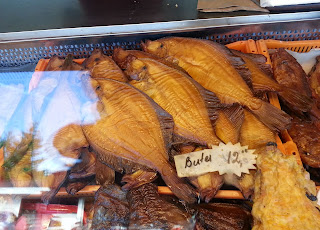You might have noticed that
over the last months my blog posts have been jumping here, there, everywhere. Our
trip to Latvia this summer yielded so many topics that I wanted to write about,
that a rather long line of posts lined up concerning the end of summer/fall
back here in the US, of which a few managed to interrupt the queue before
present day posts cut in line and mixed up everything. The reality is that I’ve left the story of our
adventures in Latvia unfinished (at least in my eyes), and with December and
the beginning of 24 Days of a Baltic Christmas rapidly approaching the
nonsensical order is guaranteed to continue at least until the end of the
month.
When I
last left off in Latvia we had just emerged from a hike in the bogs of Ķemeri
National Park, an
amazing ecosystem of incredible biodiversity and beauty. From there we headed
north through the park past Lake Kaņieris, to the coast of the Baltic Sea. The
coastal sand dunes stretch along most of the shore, continuously changing due
to the effects of the wind and waves. To reach the sea we parked on Highway P128, and after a
short walk through the inland dunes (which are more stable and covered by pine
forests) we emerged to blinding blue skies. Despite the warm temperatures and sunshine
the seashore was almost empty – the majority of beachgoers having stopped short
at the Jūrmala
strand.
Our
destination was actually not the sea, but Ragaciems, and so we continued east towards Jūrmala. Primarily a fishing
village, it is also known for being the birthplace of poet Imants Ziedonis. Separated
from neighboring Lapmežciems by Starpiņupīte, the canal built in 1667 to connect Lake Kaņieris to
the sea, the village is named for the ‘horn’ (rags), or the isthmus of land that extends into the Gulf of Rīga.
Legend
has it that centuries ago locals would burn fires on the large dune nearby called Kuģu kalns, or Ship mountain, in imitation of the lights of a port. Local ships would be lured toward land, and once they had grounded the
thieves would board, stealing their cargo.
Nowadays,
the fishing village caters mostly to tourists and travelers, the fish market
well known for fresh seafood and smoked fish. We were soon on the road back to
Jūrmala,
freshly picked berries, smoked fish and local beer in hand.
After
a feast of epic proportions we walked out to the beach one last time. As the
sun set over the Baltic Sea the kids chased one another on the shallow sandbars
and played in the sand, the water near shore warmed from the summer sun. We
said goodbye twice that evening: once to the friends who had so graciously
hosted us on a memorable summer's day, and once to the soft sands of the Baltic Sea coast – it might be some
time before we see either again.






No comments:
Post a Comment